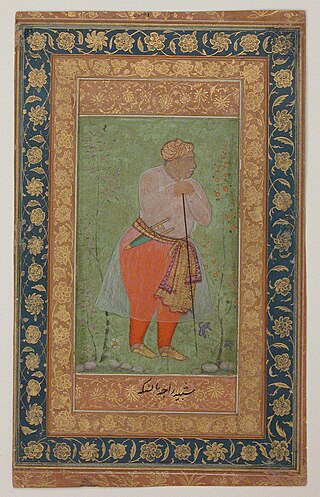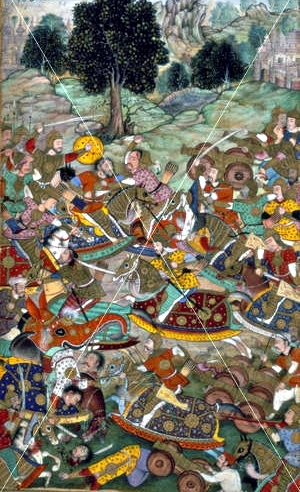
Bhairon Singh Shekhawat was an Indian politician who served as the 11th vice president of India. He served in that position from August 2002, when he was elected to a five-year term by the electoral college following the death of Krishan Kant, until he resigned on 21 July 2007, after losing the presidential election to Pratibha Patil. Bhairon Singh Shekhawat was a member of the Bharatiya Janata Party. He served as the Chief Minister of Rajasthan three times, from 1977 to 1980, 1990 to 1992 and 1993 to 1998. He represented several constituencies in Rajasthan Vidhan Sabha from 1952 to 2002. He was also awarded Padma Bhushan in the year 2003.
Sikar is a city and municipal council in the Sikar district of the state of Rajasthan in India. It is the administrative headquarters of the Sikar district. It is largest city of the Shekhawati region, which consists of Sikar, Churu and Jhunjhunu. After Kota, Sikar is one of the major hubs for private coaching in the country for competitive public examination preparations and has a number of engineering and medical coaching institutes.

Nagaur is a city and municipal council in Nagaur district of the state of Rajasthan in India. It is the administrative headquarters of Nagaur District. The Nagaur city lies about midway between Jodhpur and Bikaner.

Shekhawati is a semi-arid historical region located in the northeast part of Rajasthan, India. The region was ruled by Shekhawat Rajputs. Shekhawati is located in North Rajasthan, comprising the districts of Neem Ka Thana, Jhunjhunu, Sikar that lies to the west of the Aravalis and Churu. It is bounded on the northwest by the Bagar region, on the northeast by Haryana, on the east by Mewat, on the southeast by Dhundhar, on the south by Ajmer, and on the southwest by the Marwar region. Its area is 13,784 square kilometers.
Fatehpur is a city in the Sikar district of Indian state Rajasthan. It is part of the Shekhawati region. It is midway between Sikar city and Bikaner on National Highway 52. It is also the land to Havelis built by Marwari Seth's. It also has many Kuldevi Temples of the Agarwal community for Bajoria,Bindal, Saraf, Chamadia, Choudhary, Goenka, Lohia, Singhania, Saraogi, Bhartia Families. It is famous for its extreme weather conditions throughout the year. In winters, the minimum temperature falls below 0 °C at night for many days making it the coldest town in India in non mountainous region. In summer the temperature rises to 50 °C in the afternoon making it one of the hottest places in India. 1985 Bollywood film Ghulami starting Dharmendra, Naseeruddin Shah, Mithun Chakraborty and Smita Patil was extensively shot here in many of its havelis and the railway station.

Shekhawat is a clan of Rajputs found mainly in Shekhawati region of Rajasthan. Shekhawats are descendants of Maharao Shekha of Amarsar. The Shekhawat Rajputs trace their lineage to Shekha Rao, a prominent Rajput chieftain from the 15th century. Shekha Rao was a descendant of Rao Kalyan Singh, who belonged to the Kachwaha Rajput clan. Rao Shekha established his own principality in the Shekhawati region of Rajasthan, which includes parts of present-day Jhunjhunu, Sikar, and Churu districts. His leadership helped consolidate Rajput power in this region. Over time, the Shekhawat Rajputs expanded their territories and established several forts and palaces. The Shekhawat Rajputs established their dominance in the Shekhawati region in the 15th century, specifically starting around the time of Shekha Rao's rise to prominence in the early 1400s. They played a significant role in regional politics and were known for their martial prowess and resistance against Mughal expansion. Their rule continued until the mid-20th century when the princely states were integrated into the Indian Union. Thus, the Shekhawat Rajputs governed the Shekhawati region for approximately 500 years, from the early 15th century until the 1940s and 1950s, when princely states were absorbed into independent India. Shekhawat is a very common surname in the Indian defence forces.

Khatu Shyam Temple is a Hindu temple in Khatoo village, just 43 km from Sikar City in the Sikar district of the Indian State of Rajasthan. It is a pilgrimage site for worshipping the deity Krishna and Barbarika who is often venerated as a shyam baba. Devotees believe the temple houses the head of Barbarika or Khatu-shyam, a legendary warrior who sacrifices his head upon the request of Krishna during the antebellum of the Kurukshetra War.

RajaMan Singh I was the 24th Maharaja of Kingdom of Amber from 1589 to 1614. He also served as the Subahdar of Bihar from 1587 to 1594, then for Bengal for three terms from 1595 to 1606 and the Subahdar of Kabul from 1585 to 1586. He served in the Mughal Army under Emperor Akbar. Man Singh fought sixty-seven important battles in Kabul, Balkh, Bukhara, Bengal and Central and Southern India. He was well versed in the battle tactics of both the Rajputs as well as the Mughals. He is commonly considered to be one of the Navaratnas, or the nine (nava) gems (ratna) of the royal court of Akbar.
Loharu is a city, municipal committee and assembly constituency, near Bhiwani City in the Bhiwani district of the Indian state of Haryana. It is the administrative headquarters of one of the four administrative sub-divisions of the district and covers 119 villages. It is also a railway junction station.

Khatoo or Khatu is a Town of religious importance 43 km from Sikar City & 17 km from Reengus town in Sikar district in the Indian State of Rajasthan. The Sikar district falls under the Dhundhar region of Rajasthan. Khatoo village is home to a famous Khatu Shyam Temple, one of the most sacred temples in India. In Rajasthan, Hindu deity Barbarika is worshipped as Khatu Shyam.

The Kingdom of Amber, later the Kingdom of Jaipur or the Jaipur State, was located in the north-eastern historic Dhundhar region of Rajputana and was ruled by the Kachwaha Rajput clan. It was established by Dulha Rai, possibly the last ruler of the Kachchhapaghata dynasty of Gwalior who migrated to Dausa and started his kingdom there with the support of Chahamanas of Shakambhari in the 12th century. Mostly through 12th to 15th century, the kingdom faced stagnation, sources were scarce. Under its ruler, Raja Chandrasen of Amber became a Sisodia vassal and fought in the Battle of Khanwa under Raja Prithviraj Kachhwaha.

Raja Raisal, reigned 1584 to 1614, He married Chauhan Rajput Princess Kisnavati Nirban, the only daughter of Raja Peetha Nirban of Khandela and thus, was also the 1st Shekhawat Raja of Khandela. Son of Maharao Suja of Amarsar, was granted the estate (jagir) of 7 villages in Lamiya on death of his father, thereupon he joined Imperial Service at Delhi where he was granted the title of "Raja" also a title of "Darbari" and a Mansab of 1250 sawars which was later raised to 3000 by Emperor Akbar. He died about 1614 in South India. He was great-grandson of MahaRao Shekha, King of Amarsar and he belonged to the Kachwaha Clan of Amber/Jaipur Royal Family. The Shekhawats ruled over the Shekhawati region for over 500 years and are honoured with the hereditary title of "Tazimi Sirdars", whom the Maharaja of Jaipur receives by rising from his seat.
Tain is a village in the Jhunjhunu district, India. It is part of the Shekhawati region of Rajasthan.

Kingdom of Marwar also known as Jodhpur State during the modern era, was a kingdom in the Marwar region from 1243 to 1818 and a princely state under British rule from 1818 to 1947. It was established in Pali by Rao Siha, possibly a migrant Gahadavala noble, in 1243. His successors continued to struggle against regional powers for domination and 9 out of 15 rulers till 1438 died in combat. In 1395, its capital was changed to Mandore by Rao Chunda of Mandore and to Jodhpur in 1459 by Rao Jodha.
Danta Ramgarh is a census town and a tehsil of Sikar district in the Indian state of Rajasthan. Ex vice president of India Bhairon Singh Shekhawat, was born in village Khachariyaws near the east of Ramgarh. Dantaramgarh tehsil is the largest tehsil in Sikar district and its population is above 300,000. This village is famous for its strategic fort built by Guman Singh Ladkhani in 1744. The view of the surroundings from the top of the fort is breath-taking. Baba Balinath was a very popular saint about 400 years back. He is regarded as a village deity in the area.

The Mughal–Rajput wars were a series of battles between the Rajput Confederacy and the Mughal Empire. The conflicts originated with the invasion of northwestern India by the Mughal ruler Babur, to which the head of the Rajput confederacy, Rana Sanga, offered staunch resistance. The conflicts went on since 1526 for over 200 years, with the Mughals having the upper hand until the death of Aurangzeb in 1707, following which they entered a declining phase and the Rajputs gained the upper hand, with the last recorded conflict taking place in 1779.
Mundru is an old historical village in Sri Madhopur tehsil of Neem ka thana district of Rajasthan, India.
The Battle of Mandan was fought between the Shekhawat chiefs and the Mughal Empire due to their refusal to pay tribute to the emperor. The Mughals were Helped by Ahirs of Rewari under Mitra Sen Ahir and the Baloch chieftains Peero Khan and Kale Khan.










